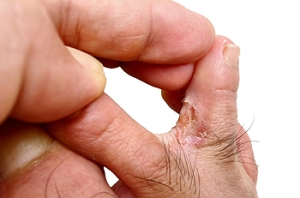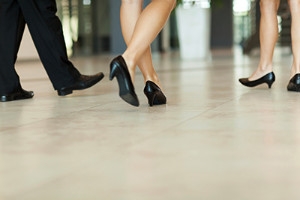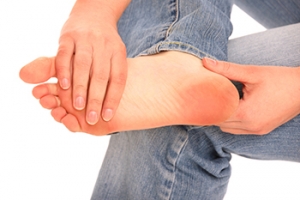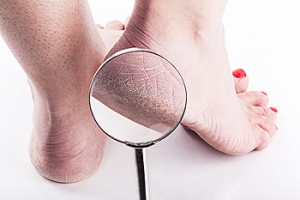Super User
Choosing the Right Running Shoe
Finding the right shoes to run in can be a headache. With so many options on the market, it can be difficult to determine exactly the right type of running shoes for you. This is where your chiropodist can help. In addition to taking into consideration the type of running you will be doing, it’s also very important to buy running shoes that cater to the individual needs of your feet.
There are many individual foot differences that can have a bearing on which types of running shoes to buy. Your gait, or walking pattern, may require certain specifications to ensure the safest and efficient running possible. A chiropodist can perform a gait analysis to determine your needs. Generally, people’s gaits can be normal, overpronated, or underpronated. Having an overpronated gait means that the foot rolls too far inwards while you walk or run. This can be mitigated by choosing stability running shoes. Having an underpronated gait means that the foot rolls too far outwards while walking or running. This can be helped by choosing shoes with neutral cushioning.
In general, it’s suggested that you shop for shoes in person in the late afternoon or evening. Shopping in person will allow you to try on and test out the shoes. You would also be able to get assistance from a store associate, who could measure your feet and provide recommendations. Shopping later in the day is suggested because your feet naturally swell throughout the day and are at their largest in the late afternoon and early evening. Your feet also naturally swell while you run. By fitting your feet when they are at their largest, you can ensure that they will fit properly throughout the day.
For more information about how to find the best running shoes for you, please consult with a chiropodist.
Symptoms and Causes of Athlete’s Foot
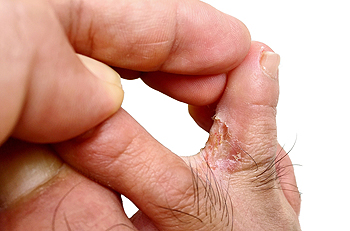
Athlete’s foot is a common fungal infection that, while highly contagious, is generally not detrimental. Anyone who comes into direct contact with the tinea fungus can get athlete’s foot. This fungus thrives in a warm, moist atmosphere frequently found in gym locker rooms, public showers, and swimming pools. For that reason, wearing appropriate shower shoes or flip-flops in such areas is recommended. Because the fungus also can be transmitted simply by using a towel of someone who is infected, sharing towels should be avoided. An athlete’s foot infection causes itchy blisters to form between the toes or on the bottom of the feet. Sometimes, they may ooze or crack the skin, leaving the area more vulnerable. A number of antifungal creams, lotions, sprays, or powders are available to fight off the fungal infection. However, it is suggested that you seek the help of a chiropodist if your foot is red, hot, and painful, which may be signs of a more serious infection. If you have diabetes or a weakened immune system, a visit to the chiropodist is also strongly suggested.
Athlete’s foot can be uncomfortable and unsightly. To learn more about preventing and treating this condition, please consult with one of the chiropodists from The Footcare Centre. Our chiropodists will assess your condition and provide you with quality foot and ankle treatment.
What Is Athlete’s Foot?
Athlete’s foot refers to an infection of the skin on the feet that is caused by a fungus. This fungus is contagious and thrives in warm and moist environments. It is often spread in common areas such as public pools, locker rooms, and showers. It can also spread when sharing personal items, like shoes or towels, with an infected person.
Symptoms
The symptoms of athlete’s foot may include:
Itching, stinging, or burning of the skin on the feet
Cracking or peeling skin, especially between the toes and on the soles of the feet
Scaly, red rash on the foot
Blisters
Foul odor
Treatment
Treatment for athlete’s foot typically involves using over-the-counter topical antifungal medications on the feet. When over-the-counter options are ineffective, you may need to take prescription oral medications or topical antifungal drugs, or a combination of both.
Prevention
Preventing athlete’s foot places an emphasis on good foot hygiene practices.
You can prevent athlete’s foot by:
Washing and drying your feet thoroughly every day
Wearing shoes when walking in public areas
Not sharing personal items, like shoes or socks, with others
Wearing shoes and socks made out of breathable materials
If you have any questions, please feel free to contact our office located in . We offer the newest diagnostic and treatment technologies for all your foot care needs.
Athlete's Foot
Athlete’s foot, also known as tinea pedis, is a fungal infection of the skin of the feet. The fungus that causes athlete’s foot lives and thrives in warm, moist environments such as public swimming pools, locker rooms, and showers. This fungus can infect the feet through a cut or crack in the skin. Athlete’s foot is also highly contagious, and the fungus can spread from person to person through sharing personal items such as shoes, socks, or towels.
The symptoms of athlete’s foot include itching, stinging, or burning between your toes or on the soles of your feet, itchy foot blisters, and dry, cracked, or peeling skin on the feet. The infection can also spread to your toenails, leading to discoloration, thickening, and crumbling.
Through a physical examination, athlete’s foot can be diagnosed by your chiropodist based on its symptoms. Sometimes, a skin test may be ordered to confirm the diagnosis. Athlete’s foot can be treated with both oral and topical over-the-counter or prescription medications. You can prevent a fungal infection by maintaining good foot hygiene, wearing shoes when walking in public areas, avoiding sharing personal items with others, and keeping your feet clean and dry.
Avoiding Pain When Standing All Day for Work
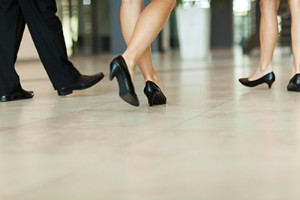
Blisters, shin splints, and swollen feet are just a few of the foot problems that can result from standing all day at work. There are various ways to take the load off your feet, during your working hours and after. Some of these include making sure to wear properly fitting, supportive, cushioned, close-toed, and comfortable shoes. Using anti-fatigue mats for repetitive tasks, doing exercises to strengthen the feet and legs for demanding work endurance, and taking regular breaks also help. Massaging your feet and soaking them after work may help relieve aches and pain. There are many other ways to prepare and take care of the feet when you must stand on them for prolonged periods. It is suggested that you visit a chiropodist to find out more.
If you stand all day, you may be at an increased risk of developing various foot conditions. If you are experiencing foot pain of any kind, please consult with one of the chiropodists from The Footcare Centre. Our chiropodists will assess your condition and provide you with quality foot and ankle treatment.
What Foot Problems Are Caused by Standing?
Standing all day at work may increase your risk of developing foot or ankle problems.
Some common foot conditions that may arise from spending all day on your feet include:
Foot pain
Blisters
Corns and calluses
Arthritis
Flat feet
Bunions
Sprains
Athlete’s foot
Prevention
If you stand for prolonged periods of time for work, taking preventative measures to preserve the health of your feet is strongly recommended.
Measures you can implement to help prevent foot problems include:
Wearing shoes that are comfortable and fit well - these shoes should be made of breathable materials and provide you with arch support and cushioning. It is best to avoid shoes that have heels or narrow toe boxes.
Taking breaks to rest, walk, and stretch your feet throughout the day
Maintaining good foot hygiene - wash and dry your feet thoroughly every day
If you have any questions, please feel free to contact our office located in . We offer the newest diagnostic and treatment technologies for all your foot care needs.
Working on Your Feet
Standing for prolonged periods of time can cause damage to your feet. Unfortunately, this is a necessary part of the job for many working people. Common foot conditions that may occur as a result of being on your feet all day include foot pain, blisters, calluses, corns, arthritis, toe deformities, sprains, bunions, athlete’s foot, and fallen arches.
There are certain steps that you can take to prevent work-related foot problems. If you are on your feet all day, it is recommended that you avoid shoes that have high heels, pointed toes, a fit that is too loose or too tight, and a lack of arch support. If you work in a place where foot injuries are a common occupational hazard, such as a construction zone, wearing the right shoes becomes increasingly important. Wearing comfortable, properly fitted, supportive shoes made of breathable materials can mitigate the risk of developing a variety of foot problems.
Maintaining an immobile, upright stance for prolonged periods of time is bad for your foot health. If possible, take breaks throughout the day to sit down, stretch, and walk around. At home, take care of your feet with a daily foot care routine. Wash the feet daily with soap and water and dry them thoroughly. Apply a moisturizer to prevent cracked heels. When trimming the toenails, trim straight across to avoid ingrown toenails. Wear clean socks daily. If you notice any problems developing in your feet or ankles, consult with a chiropodist, who can diagnose and treat your condition and help you maintain the health of your feet.
Our Culture
Whilst the scope of practice may be slightly different between our two practices; the culture within the two practices is very much the same. (Check out our other blogs on our practice in Weybridge, Surrey, UK, and Niagara Falls, Canada).
The culture of the place has been discussed to some extent in a previous blog which can be viewed here.
However, to get a real appreciation of what life is like it’s always nice to ask others and it is no better reflected than when we ask new graduate and student-visitors attending our practices what their experience has been like. It is pleasure to be able to share the experience below of Ben Morris who joined our Weybridge practice, initially observing and assisting in 2022, just after he completed his MSc in podiatry and Lulian Corila who attended our Niagara Falls, Canada practice as a student during his training at in 2023 for some observational work.
Ben Morris, MRCPod, MSc Pod
“I joined The Footcare Centre in the summer of 2022 after attending the University of Brighton. The team at The Footcare Centre offered me the opportunity to attend the practice prior to my registration to assist in the transition from student to practitioner. Throughout the summer I met the team, shadowed experienced podiatrists and health professionals at the practice. I was able to develop my knowledge of new treatments offered (including needling, Low Level Laser and shockwave therapy) and I was also able to familiarise myself with additional local practitioners to aid with referrals, and observe biomechanical assessment and nail surgery.”
Lulian Corila Student, The Michener Institute, Toronto, Canada
“My Experience in Clinic at the Footcare Centre. This summer I have had the pleasure of shadowing Stuart Berry at his practice where I was able to witness the intricacies of the profession and gain valuable experience in the clinical setting. Being part of their team reinforced my interest in chiropody/podiatry and supplied me with knowledge that I was not able to collect at my school placement.
Working at the Footcare Centre was beneficial as their wide scope of practice made it possible for me to see the variety of pathways that podiatry offers. During my clinical placement at school, most of our visits consisted of routine care which made it difficult for me to apply my knowledge that was gained throughout the semester. After the completion of my first year, I felt that I was knowledgeable in theory but wanting to reinforce all the information I gathered which attracted me to Stuart’s practice. In my first week, I was able to oversee more cases than I did in 4 months’ worth of clinical practice at school, which has not only better prepared me for my second year, but also showed me what private practice is really like. From sport injuries and tenotomies to ischemic ulcers, I realized that the day to day operations of private practice is exactly what I was hoping it would be like.
The most fulfilling aspect of my time at the Footcare Centre was seeing the wide spectrum of ages that come for treatment to Stuart’s practice. We are able to help people return to their regular activities and live the lives that they want through various stages of life. From children to elderly patients, the importance of our profession was magnified to an extent that I was unaware of. In addition to this, seeing how relieved and happy people felt after their visits provided me with a great example of how fulfilling this profession can be.
The Footcare Centre is also fully equipped with technologies and interventions that I have not even learned in school yet. Being in a practice that is up to date is not only a testament to Stuart’s dedication to providing his patients with the best possible care, but is an example of how a practice can continue to better itself which is important.
Stuart’s professionalism, passion and ability to build relationships with his clients and staff reflected in the environment of the clinic that fostered comfort and a family-like feel. It is a perfect model of what a practice should feel like.”
Foot Pain From Using an Elliptical Machine
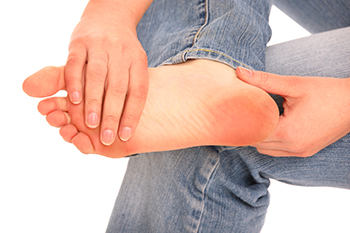
Some people find the elliptical machine to be an enjoyable and effective form of cardio fitness. These machines typically include an arm workout along with the movement of the legs. It is important to use these machines properly as repetitive stepping motion can cause foot pain. Heel pain is often a risk of using such machines in the wrong way. Some things to tend to when relying on this form of exercise include wearing running shoes that are comfortable and supportive, stretching the feet before embarking on a workout, and making sure feet are placed flat on the pedals of the machine rather than pushing off from the toes. If you use the elliptical machine as a form of exercise and would like to learn more about using it safely, it is suggested that you consult with a chiropodist for more advice.
Injuries to the foot and ankle are very common among athletes. If you have experienced an injury, please consult with one of the chiropodists from The Footcare Centre. Our chiropodists will assess your condition and provide you with quality foot and ankle treatment.
Common Injuries Among Athletes:
Achilles tendon injuries
Ankle strains or sprains
Plantar fasciitis
Fractures
Turf toe
Joint dislocations
Sever’s disease
Morton’s neuroma
Symptoms
Symptoms will depend on the cause and severity of the injury. Common symptoms for a foot or ankle injury include pain, swelling, tenderness, bruising, a reduced range of motion, and difficulty bearing weight or walking on the affected foot or ankle.
Diagnosis
Sports injuries are typically diagnosed after carefully examining the affected foot or ankle. This includes moving the injured area to test its range of motion. Medical history will need to be provided, as well as detailed information about how the injury occurred. Imaging studies, such as X-rays or MRIs, may be used to confirm or rule out certain diagnoses.
Treatment
Just like symptoms, treatment will depend on the type of injury and its severity. Initial treatment for many sports injuries is aimed at controlling inflammation and promoting the healing response. The acronym R.I.C.E is a helpful guide to implement for most acute injuries. This method involves resting, icing, compressing, and elevating the affected foot or ankle. In addition, anti-inflammatory medications may be administered and orthotic devices may be prescribed. For more severe injuries, surgery may be required. Lastly, rehabilitation or physical therapy may be needed to gain full functionality in the afflicted area.
If you have any questions, please feel free to contact our office located in . We offer the newest diagnostic and treatment technologies for all your foot care needs.
Reasons Cracked Heels Can Develop
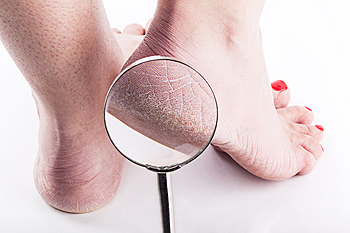
Mildly cracked heels may feel better when a good moisturizer is applied daily. This is a foot condition that can happen for various reasons, including standing on hard surfaces for most of the day. It may also occur from wearing shoes that have an open back, such as flip flops, or possibly from washing the feet with harsh soaps. There may be existing medical conditions that can cause cracked heels to develop. This condition may be common for diabetic patients to get, who are often aware of the serious consequences if prompt medical attention is not received. Many people who are diabetic are unable to feel cuts on their feet, and cracked skin on the heels may rapidly become infected. Some people get cracked heels from a vitamin deficiency, or from a skin or thyroid disorder. If you have cracked heels, it is strongly suggested that you are under the care of a chiropodist who can provide you with the correct treatment techniques.
Dry, cracked heels are more than a cosmetic inconvenience. For many people, they are uncomfortable, deep, painful, and may even bleed. If you suffer from cracked heels, please consult with one of the chiropodists from The Footcare Centre. Our chiropodists can help you maintain the health of your lower limbs and your mobility.
Causes
Prolonged standing
Wearing open-back shoes
Wearing shoes that don’t cushion the heels
Living in a cold or dry climate
Taking long, hot showers
Not moisturizing the heels
Eczema
Psoriasis
Palmoplantar keratoderma
Juvenile plantar dermatosis
Treatments
Soaking the feet
Exfoliating with a pumice stone
Moisturizing the heels
Wearing closed-back shoes that cushion heels
Avoiding prolonged standing
Taking warm, rather than hot, showers
Treating underlying skin conditions
While milder cases of cracked heels can be treated at home, some patients present with deep, painful, bleeding heel fissures that are at risk of becoming infected and may require medical care. Additionally, patients with diabetes or any other conditions that affect the immune system should be monitored by a chiropodist.
If you have any questions, please feel free to contact our office located in . We offer the newest diagnostic and treatment technologies for all your foot care needs.
Cracked Heels
When the skin on the heels is dry, it may begin to crack. These cracks are not just unsightly, they can also be uncomfortable or deep and painful. In some cases, these heel cracks can even bleed, increasing their risk of becoming infected. This can make walking, standing, or even bearing weight on the heels difficult.
Cracked heels can be caused by a variety of factors. These include prolonged standing, wearing open-back shoes or shoes that don’t cushion the heels, living in a cold or dry climate, taking long, hot showers, and not moisturizing the heels, as well as various medical conditions, such as eczema, psoriasis, palmoplantar keratoderma, or juvenile plantar dermatosis.
The best way to prevent and treat mild cases of cracked heels is to regularly soak the feet, exfoliate the heels with a pumice stone, and then moisturize them. It is also best to avoid wearing open-back or thin-soled and unsupportive shoes. In more severe cases, it is suggested that you seek the care of a chiropodist, who can help you manage your cracked heels and overall foot health. People who have cracked heels and diabetes or a weakened immune system should also be under the care of a chiropodist.
